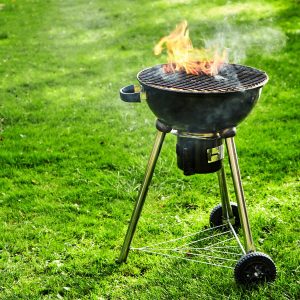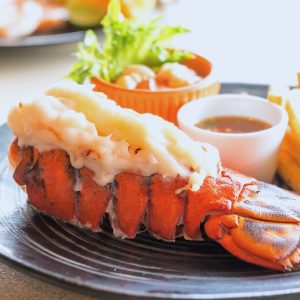The Importance of Internal Cooking Temperatures
You may have seen my blog on wood-burning ovens describing the oven we just installed on our patio. I have been having fun making pizza but also trying to roast meat and slow cooking overnight using the oven’s residual heat.
It has been quite a learning curve but a lot of fun with excellent results. One detail I’ve learned in the past two weeks about cooking is the importance of knowing the internal temperature of your cooking.
Not that I didn’t know this about cooking, but when you can’t accurately regulate the oven’s temperature like you can with a conventional oven, you depend on knowing the internal temperature.
Please take a look at my meat doneness chart for internal cooking temperatures.
Forget About Cooking Times
Most recipes tell you how long to cook something and at what temperature. Just look through any cookbook. If roasting, they tell you to preheat the oven to a specific temperature and roast for so many minutes.
If grilling, they tell you to start at the highest temperature for so many minutes and then finish on the cooler part of the grill for so many minutes. The same is true for sautéing, braising, or whatever other way you cook.
This would be great if everyone’s oven or grill were identical. How about different sizes of what you are cooking? The recipe might be for a 2-inch thick chop, but you purchased a 1 ¼ inch chop. They tested the recipe in a heavy-bottomed copper pan over a commercial grade.
Viking stove top, but you own less expensive cookware and cook on a GE electric range. These factors will all affect the cooking times and final results.
Rare, Medium-Rare, Medium, Medium-Well
Don’t believe you can’t get your steaks to the exact doneness you like and can only get results like that in a restaurant. How many times have you ordered a medium-rare steak that comes out medium-well?
Do you send it back? (That’s a question for another post)
Most home cooks have learned to cook using time and external temperature as our guide. It’s easy, and so what if the meat is a little overcooked? How many of you purposely-under-cooked meat, knowing you can throw it back on the heat?
Or have you overcooked it using the excuse, “I want to make sure it’s safe”? I know I have.

Taking The Guesswork Out
Cooking in a wood-burning oven, where I find it almost impossible to keep the heat source constant, there is a lesson to be learned. The lesson is knowing the desired internal temperature of what I am cooking and using an instant thermometer to monitor it. I learned this when cooking a pork roast last weekend.
Do You Use An Instant Thermometer?
As many recipes will tell you, I can’t set the oven to 350ºF or 400º F and cook the roast for 15 minutes per pound. Each time I put a log on the fire to keep it burning, the temperature in the oven changes.
Instead, I try to keep a somewhat constant temperature but monitor the pork roast’s internal temperature until it reaches my target of 150º F knowing it will reach my ideal internal temperature of 160º F after resting.
What’s This About Resting?
Meat & poultry need to rest before carving. They need time to redistribute the juices so they don’t all leak out as soon as you make that first cut.
They need time to even the temperature throughout. While your meat is resting, the internal temperature rises 5º to 10º F because it continues to cook internally.
So if you are trying to reach an ideal internal temperature of 145º F for that perfectly grilled New York Strip steak, you want to cook it to 140º F and let it rest for 5 – 10 minutes until it reaches 145º F. Now you are cooking like a pro.
Try This At Home
Grill two steaks any way you like. When you think they are perfect, let one rest and cut into the other.
You should notice the steak that didn’t rest will bleed out a lot of juices, the steak will appear undercooked (very pink) in the center, and I’m guessing the meat will be chewy. (This is why cutting into a steak or any meat is a bad idea to test its doneness. You bleed out the juices that keep it moist.)
Let the other steak rest for 5 – 10 minutes and then cut into it. There should be a lot less juice bleeding out, the meat will be more even in color, and it should be tenderer than the other piece.
If you have an instant thermometer, see the steaks’ internal temperature. Is your medium-rare steak at the correct temperature, or is it overcooked?
Using an instant thermometer and knowing your desired temperature can help you prepare perfect steaks every time. You have to take it out of the drawer and use it.
What About Testing By Touch?
We have all heard you can test the doneness of a cooked piece of meat by comparing the firmness of the meat to the flesh at the base of your thumb. I have told people to do this and have believed it to be true for years, and it may work, but if I compare my hands to my wife’s, my steak will always be overcooked if I’m doing the grilling. Our hands are that different.
Conclusion
Go out and buy a good instant thermometer. If you already have one, use it. I can’t tell you how accurate and tasty your results will be if you depend more on actual internal temperatures than cooking times and external temperatures.
Check out my meat doneness chart with ideal temperatures and when to remove from heat temperatures. These are based on how I like my meat cooked and may differ from your preferences.
If that’s the case, make your chart, print it out, and have it in your kitchen. You will notice a difference.













7 Responses
I have always let my meat rest, but it becomes too cool and by the time i serve it is no longer hot…how do i overcome this?
Hi Blondee47,
I have asked several chefs this same question with various responses. Some say the exterior cools down but not the interior. Some have said to use an aluminum foil tent. I have heard you can keep it at a low, low temperature in the oven while it is resting and I guess in restaurants they have heat lamps.
so what temp is it when its finally done?
Griff, it depends on what you are cooking and how well done you like it. Check the Meat Doneness Chart link in the post.
I have had a taste ability for my entire life. I decided to become a professional chef recently when I caught a smell from a cooking pot of pasta. My nose told me the pasta was done. It was perfect. I have a history in the kitchen.
I am by nature artistic. At this crossroads this is a nobrainer.
using the Meat Doneness Chart – is the meat supposed to be at the suggested temperature when you remove it from the heat? Does “resting” it increase or decrease the interior temperature?
Hi Kay, on my meat doneness chart you will see “remove” and “ideal”. The remove temperature is the temp you want to take it away from the heat. While it’s resting, the interior temperature increases to the ideal temperature. Hope this helps – RG
RG, I have used instant thermometers and when I insert the probe (into my turkey or roast) juice runs out; is this okay since its just a tiny hole versus making a cut with a knife to check?
Also, is there a thermometer I can keep inserted into the meat and check without removing until the bird or roast reaches the desired temperature; or is this not a good thing to do? Mainly, I see this as a way to avoid loss of any juices if I insert before cooking and don’t remove until I reach the desired temperature .
Hi Cynthia, I used to think that poking a turkey or piece of meat with an instant thermometer would release all the juices and dry out the meat but that’s just not true. If you want to insert a meat thermometer and leave it, there are lot’s of brands on the market. Some like the one I describe at Talking Thermometers lets you go wireless.
I have another one I like that has a wire that attaches the probe to the thermometer so you don’t have to open the door to read it. And if you are saving money, you can purchase the old fashion version that you probably remember as a kid. -RG